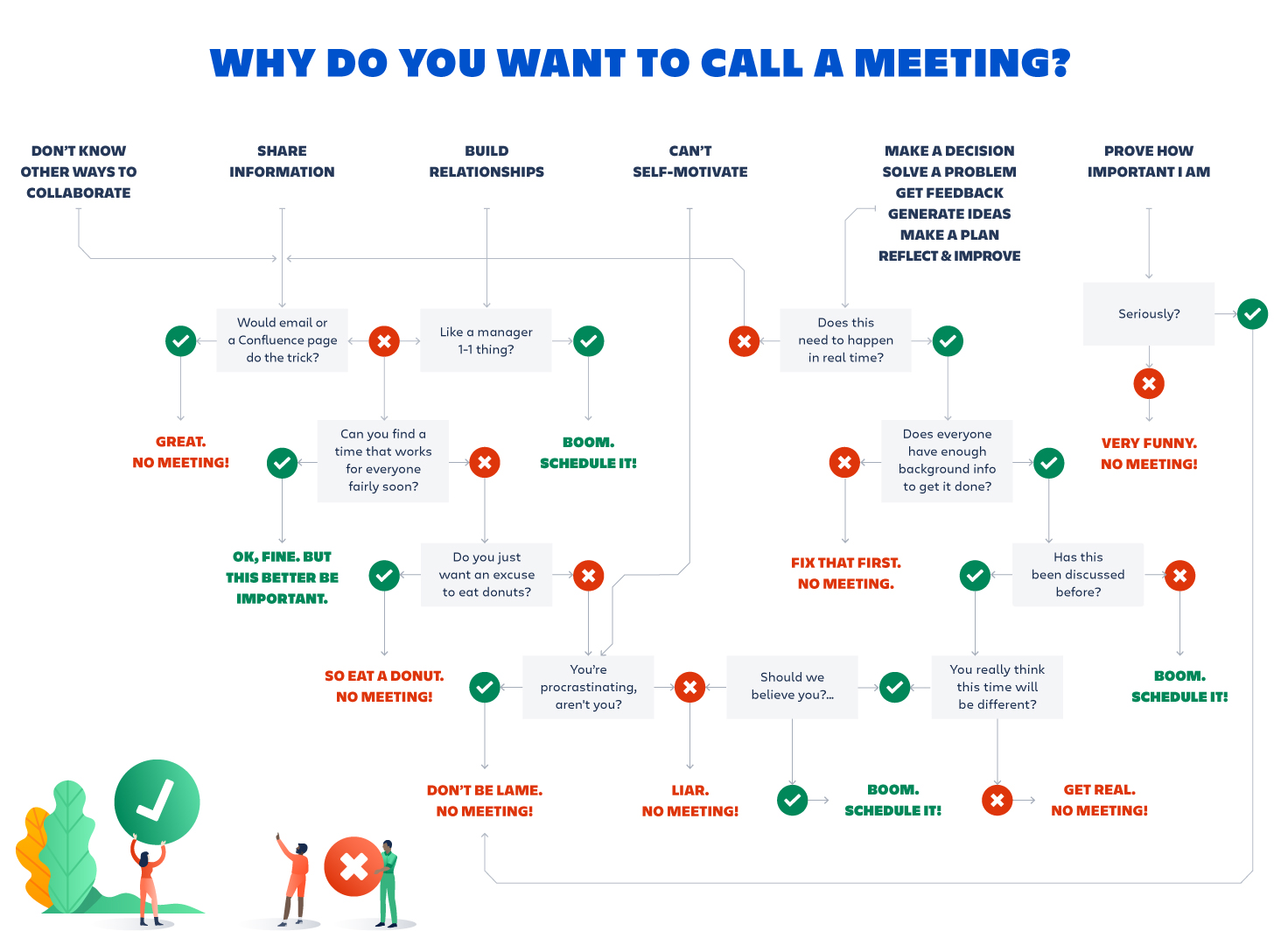5-second summary
- If you’re calling a meeting to make a decision or have a discussion that’ll be faster in real time, that’s cool. If you just need to broadcast information, share it in writing.
- Choosing participants with diverse perspectives helps you see the topic from multiple angles, and therefore, get the most out of your meeting.
- When leading meetings with both in-person and virtual attendees, make sure each group is participating equally so nobody checks out.
If I told you that only 50% of meeting time is used effectively, would you believe me? (Don’t answer. I can hear you nodding from here.) There’s evidence that virtual meetings score even lower.
And get this: an ineffective meeting can derail productivity even after it’s over. A recent article in the MIT Sloan Management Review details something called “meeting recovery syndrome” where attendees lose work time while they mentally recover from a bad meeting.
Most of us don’t have formal training in meeting management skills, but anyone can learn to do it well – whether your team is in the office, fully distributed, or hybrid.
What makes an effective meeting?
It’s important to distinguish between effective and efficient.
An efficient meeting starts promptly, stays on track due to good time management, includes as few people as possible, and achieves the stated objective.
Job done, right? Wrong.
Efficiency is a superficial quality. It says nothing about whether the right people were included for the right reasons, or whether the meeting generated any value.
An effective meeting brings a thoughtfully selected group of people together for a specific purpose, provides a forum for open discussion, and delivers a tangible result: a decision, a plan, a list of great ideas to pursue, a shared understanding of the work ahead. Not only that but the result is then shared with others whose work may be affected.
Successful meetings have a clear purpose
Most of us want fewer meetings on our calendars. It’s easy to fall into the trap of thinking that meetings are the one and only way to collaborate. That knee-jerk tendency gets us into trouble and gives meetings a bad name.
First, determine whether you really need a meeting
You don’t need a meeting to broadcast information – that’s what email, chat, and company intranets like Confluence are for. Department and company all-hands meetings are a notable exception. They provide a unique chance to hear directly from executives and other decision-makers – and, if they include time for Q&A (which, they should), they get to hear from you.
If your meeting features a productive discussion that will be more effective in real time than asynchronously via emails or comment threads, then it’ll be worthwhile. Examples include team or project retrospectives, brainstorming, and one-on-one meetings between managers and their direct reports.
In the best-case scenario, a meeting’s purpose is to decide or create something collaboratively. Project planning, mapping out customer journeys, setting goals, solving a problem, choosing X vs. Y … all these are situations where holding a meeting is probably the most effective way to collaborate. And thanks to Trello boards, Miro boards, and Zoom’s virtual whiteboarding feature, you don’t even need to be in the same room to get it done.
Next, choose meeting participants who can make a unique contribution
Meetings are expensive, so be thoughtful about who you invite. To be sure, you want to invite the minimum number of people needed to achieve your goal. But you also want the group to bring diverse perspectives and knowledge, especially if the purpose of the meeting is decision-making or brainstorming. Sadly, there’s no magic formula for balancing cost against the potential for creativity, so you’ll need to use your best judgment.
Tip
Try this meeting cost calculator from Harvard Business Review next time you’re running a meeting. It’ll make you think twice about your attendee list!
Last, craft and share an agenda
Few things are more irksome than the person who sends a meeting invite with no indication of what will happen, and therefore no clue as to why you’re being invited. Don’t be that person. Include your agenda in the invitation so people can determine whether they need to be there and, if not, decline the meeting or suggest someone else.
Your meeting agenda might have just one item. That’s fine! The point is to have an agenda that speaks to the result you want – e.g., “Brainstorm 10 or more ways we could reduce customer churn 10% by the end of the year.” If you can’t describe what you’ll be doing in actionable, results-oriented terms, that’s a sign holding the meeting would be a waste of time.
Tip
Include a 5-minute agenda item at the end to capture any open questions or follow-up tasks and assign owners for them. Don’t skip this! Better to cut a discussion short than to leave loose ends dangling.
Effective meetings keep attendees engaged
It’s okay to start the meeting by setting the expectation that everyone is 100% present and focused. Let the group know that if someone has work that is so pressing they’d be tempted to multi-task, they have permission to go do that work and catch up on what happened in the meeting later. They’ll produce better work, and you’ll have more engaged participants. Win-win.
Schedule for maximum engagement
In our age of globally distributed companies and remote work, a bit of thought around timing is key to effective meeting management. As much as possible, avoid scheduling your meeting during someone else’s lunch hour, or at a time when they’d otherwise be reading their kids a bedtime story. When that can’t be avoided, at least check in with the people who’ll be inconvenienced to get their buy-in in advance. (Depending on your company culture, that might not be strictly necessary, but it’s always polite.)
Even for co-located participants, meeting time can make a difference. Our capacity for creative thinking is the highest right after sleep, so schedule that brainstorming session first thing in the morning. By contrast, we solve problems best later in the day when our minds are a bit tired. Our focus relaxes, and we can see more opportunities and connect more dots. Plus, we’re less likely to be distracted by a looming list of tasks.
Encourage participation – and make it hard to zone out
If you’re meeting in person, laptops should be closed and phones should be off the table (unless you’re taking notes). “Oh, but I can focus on the topic at hand and check my email simultaneously,” some might say. Please allow me to call bullshit on that. Besides, for every person with a laptop open, there’s a person sitting next to them distracted by their typing or peeking to see if they’re just cruising social media.
If you’re meeting virtually, ask people to enable video so they’re more likely to stay actively engaged. Of course, exceptions always apply, so be understanding if some participants have to opt out of video occasionally. People may need to tend to children, they may not feel “camera ready” if the meeting falls at an odd time of day, or they may not feel comfortable broadcasting their bedroom to coworkers.
Tip
Use the meeting notes template in Confluence to save time and structure your notes for easier reading.
Make it remote-friendly, even if you’re in the office
Even if everyone in the group typically works from the office, there’s always a chance somebody will end up working remotely that day to care for a sick child or let the electrician in. So set up a virtual meeting link just in case.
If you have a remote participant, consider asking the entire group to join remotely from their desks. It puts everyone on a level playing field and encourages more balanced participation. Plus, nobody likes being the giant head on the TV screen at the front of the conference room.
Effective meetings provide a safe space for divergent thinking
A bit of divergence goes a long way when you’re looking for creative ideas, puzzling through solutions to a problem, or exploring options. You don’t have to put a specific brainstorming exercise on the agenda, but you do have to make the group feel comfortable expressing opposing opinions or offering up off-the-wall ideas.
Build trust in the room
People need assurance that stepping outside the norm won’t be a career-ending move. Known as psychological safety, this is one of the leading indicators of a high-performing team. (And what is a group of people in a meeting, if not a temporary team?) As the meeting organizer and facilitator, you have a chance to lead by example and be the first to broach a controversial topic or offer an unusual perspective or idea.
You can also build trust by asking questions that prompt a deeper discussion, even when you think you know the answer. Questions like “Why do we think that’s true?” or “Can you expand on that?” or “How could we measure that?” demonstrate humility and curiosity on your part, which sets the tone for the rest of the group.
Be inclusive
If you’ve done a good job gathering a group with diverse knowledge and perspectives, everyone will be “the odd one out” in one way or another. The only introvert, the only person from finance, the person who just started last week. Your job now is to take advantage of that diversity by making sure everyone is (and feels) heard.
Ask the new hire how things look from their still-fresh point of view. Draw out the introvert toward the end of a discussion by asking whether they see points the group hasn’t considered yet. Encourage the lone representative from finance to share how the decision would affect their team. If one person starts to dominate the meeting, ask them to take over capturing notes on the whiteboard. This transitions them into listening mode and gives the rest of the group a better chance to discuss their perspective.
If your meeting includes a mix of in-person and virtual attendees, pay attention to whether participation seems balanced. It’s easy for the in-person group to dominate the discussion without realizing it. Make a point to ask the virtual attendees for input proactively throughout the meeting so you get the full benefit of their expertise.
Effective meetings produce real, shareable results
You know the meeting’s purpose because you’ve thought it through. You crafted an agenda designed to achieve the goal. Now stay the course! Be mindful not to meander off-topic or dive too deep into technical discussions. (Just how long is “too long” and how deep is “too deep” is up to you as meeting facilitator to decide.)
Tip
Create a “parking lot” on your whiteboard, your shared Confluence page, or your Trello board to capture ideas, topics, and questions outside the meeting’s scope. The catch is that you’re honor-bound to follow up on them, or you’ll lose the group’s trust.
If the meeting centers on a decision, don’t let your team members off the hook and settle for a “maybe.” Push for that decision or recommendation so people can start pursuing action items as soon as they walk out of the room. You might not reach full agreement, but that’s OK. Effective teamwork means agreeing to trust each other enough to rally behind the decision once it’s been made.
Consider using the DACI method to clarify each person’s role: driver, approver, contributor, or informed.
Chances are, your meeting will generate some kind of artifact: an action plan, a collection of ideas, a customer journey, a list of next steps, etc. Atlassian meetings typically capture all that stuff as a page in Confluence (the wiki-flavored intranet tool we make) and share the page with everyone on the invite list and other relevant people. Sharing via email and Google Docs works fine, too.
Err on the side of sharing with more people than is strictly necessary. It’s really hard to keep track of exactly what everyone around you is up to, or how the outcome of your meeting will intersect with their work. Sharing broadly reduces the chance you’ll discover conflicts late in the game, and might even lead to joining forces with a team doing complementary work.
If the meeting isn’t effective, change it!
The fact that you’re still reading means you’re committed to running a great meeting. Yay! Turns out, though, that you’re not the sole judge of whether the meeting was productive or not.
Discuss the experience with your fellow attendees, and solicit feedback with questions like these:
- Did this meeting result in something of value to the business?
- Did we include the right people? If not, who should or shouldn’t be included in the future?
- Were the meeting’s purpose and agenda clear?
- Was it easy for you to contribute to the discussion?
- For recurring meetings: are we holding this meeting on the right cadence? If not, how should we adjust?
Even if the meeting was a one-off, this feedback helps you make your next meeting better. And if (ok: when) you start to feel like your calendar is overloaded with commitments, run the Ritual Reset play from the Atlassian Team Playbook to see if you can streamline any meetings or eliminate them altogether.
Keep an ongoing, open dialogue amongst the people you meet with most frequently, and emphasize progress over perfection. Continuous improvement for the win!










































